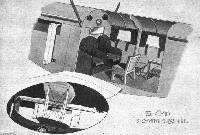
Описание
Страна : Великобритания
Год : 1919
Гражданский транспортный самолет с экипажем из одного человека
ВАТ F.K.26
Первая мировая война близилась к концу, и многие авиастроители стали переориентироваться на разработку гражданских транспортных самолетов. ВАТ F.K.26, спроектированный Фредериком Колховеном, можно назвать первой послевоенной машиной, специально предназначенной для этой роли. Вместительный фюзеляж был деревянным, покрытым тканью и рассчитан на размещение 4 пассажиров в кабине длиной 2,44 м, находившейся перед открытой кабиной пилота.
Прототип, построенный на "Willesden", лондонском заводе ВАТ, взлетел в Хендоне в апреле 1919 года. Вскоре поднялся в воздух и второй самолет, выставлявшийся на первой выставке воздушного транспорта, проходившей в Амстердаме в июле того же года. Третья машина, обозначенная ВАТ Commercial Mk 1, была показана на авиационной выставке Olympia Aero Show в июле 1920 года, а четвертая, выпущенная в ноябре 1919 года, оказалась последним самолетом, выпущенным ВАТ (компания закрылась), и летала на маршруте до Парижа в компании "Instone Air Line".
ТАКТИКО-ТЕХНИЧЕСКИЕ ХАРАКТЕРИСТИКИ
BAT F.K.26
Тип: гражданский транспортный самолет с экипажем из одного человека
Силовая установка: V-образный двигатель Rolls-Royce Eagle VII мощностью 350 л. с. (261 кВт)
Характеристики: максимальная скорость на уровне моря 196 км/ч: начальная скороподъемность 305 м/мин; практический потолок 2440 м: дальность полета 966 км
Масса: максимальная взлетная 2041 кг
Размеры: размах крыла 14,02 м; длина 10,57 м; высота 3,43 м
Полезная нагрузка: до четырех пассажиров
Описание:
- ВАТ F.K.26
- Flight, July 1920
The Olympia Aero Show 1920
Фотографии
-
Мировая Авиация 43
Одно из последних творений Фредерика Кольховена в Англии, создавшего под эгидой "Бритиш Эриал Трэнспорт Кампани" коммерческий самолет B.A.T. F.K.26, способный перевозить четырех пассажиров.
Современные исследователи полагают, что Колховен размещал пилота над и за пассажирской кабиной, чтобы увеличить его шансы на выживание в случае катастрофы, так как он является единственным человеком на борту, способным дать точное изложение аварийной ситуации. -
Flight 1920-01 / Flight
The F.K.26 commercial passenger or mail-carrier (400 lbs. load), which has already carried out a good deal of cross-country work as well as many trips to Belgium and Holland.
-
Flight 1920-07 / Flight
Side view of the B.A.T. "Commercial"
-
Aeroplane Monthly 1990-05 / J.Stroud - Wings of Peace
Регистрационный номер: G-EAAI [2], K-102 [2] G-EAAI, the first BAT FK 26, at Hounslow in October 1919. It had received its Cof A that August.
-
Aeroplane Monthly 1974-01 / P.Moss - Wings for the Empire (1)
Регистрационный номер: G-EAPK [2] AIR CONFERENCE VISIT TO WADDON: The photo, shows in the foreground a B.A.T. Commercial machine owned by the Instone Air Line and other machines in line.
D.H.16 G-EAQS of AT&T and BAT F.K.26 G-EAPK of Instone at Hounslow in August 1921. Note the position of the pilot's cockpit in the latter. It was apparently designed to give the pilot maximum safety in a crash.
Typical machines at Waddon, alias Croydon, in 1920. On the left is a D.H.16 (a modified D.H.9) used by A.T.T., and on the right is a Koolhoven B.A.T. used by Instone Air Line. In the background an Instone Vickers Vimy Commercial may just be seen.Другие самолёты на фотографии: De Havilland D.H.16 - Великобритания - 1919Vickers Vimy Commercial - Великобритания - 1919
-
Aeroplane Monthly 1990-05 / J.Stroud - Wings of Peace
Регистрационный номер: G-EAPK [2] The Instone Air Line's FK 26 G-EAPK City of Newcastle. Joining S. Instone & Co in 1920, G-EAPK flew on the London-Paris route.
-
Flight 1937-08 / Flight
The Koolhoven F.K.26 is one of a number of pioneer types and was obtained from a source apparent in this photograph of the machine being shipped to Holland some little time back.
-
Aeroplane Monthly 1990-05 / J.Stroud - Wings of Peace
Регистрационный номер: G-EAAI [2], K-102 [2] KEITH WOODCOCK'S painting also shows the first BAT FK 26, which carried the temporary registration K-102 before becoming G-EAAI.
-
Flight 1920-11 / Flight
MODERN CABIN MACHINES: The B.A.T., F.K. 26.
-
Flight 1920-07 / Flight
THE B.A.T. FOUR-SEATER COMMERCIAL AT OLYMPIA: 1, Sketch of the pilot's seat and control. 2, Detail of the trimming gear. 3, Diagram of the tail plane trimming gear
-
Flight 1920-07 / Flight
ON THE B.A.T. COMMERCIAL: Left, the interplane strut attachment; right, the wing|tip skid, and in the centre the undercarriage
-
Flight 1920-07 / Flight
THE B.A.T. COMMERCIAL AT OLYMPIA: Diagram showing the arrangement of the formers in the fuselage.
- Фотографии













